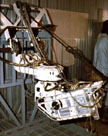Gli esperimenti di rappresentazione scientifica di Cassini,
comprenderanno una grande varietà di oggetti (Saturno,
gli anelli, Titano, i satelliti ghiacciati e i campi stellari)
e una grande varietà di obiettivi scientifici. Questi includono
studi sulle atmosfere di Saturno e Titano, gli anelli di Saturno
e le loro interazioni coi satelliti del pianeta, e le caratteristiche
superficiali dei satelliti, Titano compreso. A causa di questi
obiettivi multipli, il Sottosistema per le immagini
Scientifiche (ISS) ha due fotocamere seaparate. La prima è
una fotocamera ad angolo stretto(NAC), che otterrà le immagini
ad alta risoluzione degli oggetti di interesse: La seconda è
un grandangolo
(WAC) che fornisce
un diversa scala di risoluzione e una più completa copertura
spaziale. La navicella porterà una NAC e una WAC. La NAC
è anche usata per ottenere immagini ottiche della navigazione,
con la WAC che funzionerà come unità di emergenza
per questo scopo.
Le fotocamere sono apparecchi CCD (Charge-Coupled Device). Un CCD è essenzialmente un LSI (circuito a grande scala di integrazione - Large Scale Integration) con una stringa bidimensionale di centinaia di migliaia di pozzi a carica isolata (CCD), ognuno rappresentante un pixel. La luce che cade nel pozzo è assorbita da un substrato fotoconduttore , p.es. di silicio, che emette una quantità di elettroni proporzionale all'intenzità della luce. Il CCD rivela e immagazzina una crica elettrica cumulata che rappresenta il livello luminosoin ogni pozzo. Queste cariche sono poi lette per la conversione in dati digitali. I CCD sono molto più sensibili ad un più ampio spettro luminoso che non apparecchi come il vidicon, sono meno pesanti, richiedono meno energia e si interfacciano meglio coi circuiti digitali.
 The Cassini
imagers differ primarily in the design of the optics. The NAC
has a focal length of 2000 mm, and the WAC , which uses optics
inherited from the Voyager mission, has a focal length of 200
mm. The cameras each have a focal plane shutter of the same type
as used on both Voyager and Galileo, and they have a two-wheel
filter-changing mechanism derived from the Hubble Space Telescope
Wide Field/Planetary Camera (WF/PC) design. The CCD detector is
cooled to suppress dark current (residual current in the CCD beyond
that released by incident light), which is dependent upon temperature.
It is also shielded from ionizing radiation.
The Cassini
imagers differ primarily in the design of the optics. The NAC
has a focal length of 2000 mm, and the WAC , which uses optics
inherited from the Voyager mission, has a focal length of 200
mm. The cameras each have a focal plane shutter of the same type
as used on both Voyager and Galileo, and they have a two-wheel
filter-changing mechanism derived from the Hubble Space Telescope
Wide Field/Planetary Camera (WF/PC) design. The CCD detector is
cooled to suppress dark current (residual current in the CCD beyond
that released by incident light), which is dependent upon temperature.
It is also shielded from ionizing radiation.
The CCD detector design is a square array of 10242 pixels, each pixel 12 micrometers on a side. The IC chip will use three-phase, front-side-illuminated architecture, with a coating of lumogen phosphor to provide ultraviolet response. The detector is passively cooled by a radiator to approximately 10 degrees C below its nominal operating temperature (approximately minus 90 degrees C), and then it is controlled to the operating temperature by a proportional control heater. To minimize radiator size and heater power, the detector/radiator combination is thermally isolated from the rest of the camera head assembly (CHA).
The entire NAC is thermally isolated from the remote sensing pallet (RSP) on which it is mounted in order to minimize the effects of RSP thermal variations on NAC image quality. The WAC, being an inherited design with less stringent imaging requirements, is not thermally isolated.
The electronics for each camera are identical. All ISS command and telemetry functions will be handled by the electronics, including recipt of commands from the Command and Data Subsystem, expansion of commands, and collection and transmission of imaging data and telemetry to the CDS.
The ISS controls the amount of power it draws from the spacecraft during operations. To accomplish this, the profile of ISS command timing is structured to reduce the power the ISS requires for certain internal functions (e.g., shutter or filter wheel movement). When the filter is moving, the power from the optical heater (if present) in the active camera is turned off. When the movement is complete, the optical heater is turned on (if needed). In addition, simultaneous filter positioning within a single camera, either the WAC or NAC, is not permitted.
During the cruise phase of the mission, the cameras will periodically be turned on for maintenance, calibration, and monitoring of instrument health and performance. Other than these specified times, the ISS will be off and replacement heaters will be on. In addition, decontamination/radiation heater 1 will be on throughout most of the cruise.
Upon arrival at the Saturnian system, the cameras will be on
most of the time. Spacecraft power limitations will be the controlling
parameter determining whether the ISS will be turned off or put
into a low-power state. During the Saturn tour, high-activity
periods for Saturn and its rings will be clustered around periapsis
(the point in the orbit closest to the planet); for the satellites,
the high-activity periods will be when the spacecraft is closest
to them. At these times, high-resolution images of all targets
will be acquired through various camera filters, and the data
will be stored in the spacecraft solid-state recorder (SSR). During
lower activity periods (i.e., when the spacecraft is orbiting
farther from the targets), long-term atmospheric and ring monitoring
will take place, and ISS calibrations will be performed.